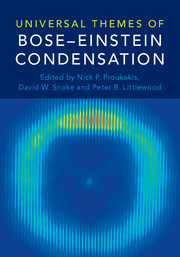Book contents
- Frontmatter
- Contents
- Foreword
- Preface
- Part I Introduction
- Part II General Topics
- Part III Condensates in Atomic Physics
- Part IV Condensates in Condensed Matter Physics
- Editorial Notes
- 19 Bose-Einstein Condensation of Photons and Grand-Canonical Condensate Fluctuations
- 20 Laser Operation and Bose-Einstein Condensation: Analogies and Differences
- 21 Vortices in Resonant Polariton Condensates in Semiconductor Microcavities
- 22 Optical Control of Polariton Condensates
- 23 Disorder, Synchronization, and Phase-locking in Nonequilibrium Bose-Einstein Condensates
- 24 Collective Topological Excitations in 1D Polariton Quantum Fluids
- 25 Microscopic Theory of Bose-Einstein Condensation of Magnons at Room Temperature
- 26 Spintronics and Magnon Bose-Einstein Condensation
- 27 Spin-Superfluidity and Spin-Current Mediated Nonlocal Transport
- 28 Bose-Einstein Condensation in Quantum Magnets
- Part V Condensates in Astrophysics and Cosmology
- Universal Bose-Einstein Condensation Workshop
- Contributors
- Index
- References
27 - Spin-Superfluidity and Spin-Current Mediated Nonlocal Transport
from Part IV - Condensates in Condensed Matter Physics
Published online by Cambridge University Press: 18 May 2017
- Frontmatter
- Contents
- Foreword
- Preface
- Part I Introduction
- Part II General Topics
- Part III Condensates in Atomic Physics
- Part IV Condensates in Condensed Matter Physics
- Editorial Notes
- 19 Bose-Einstein Condensation of Photons and Grand-Canonical Condensate Fluctuations
- 20 Laser Operation and Bose-Einstein Condensation: Analogies and Differences
- 21 Vortices in Resonant Polariton Condensates in Semiconductor Microcavities
- 22 Optical Control of Polariton Condensates
- 23 Disorder, Synchronization, and Phase-locking in Nonequilibrium Bose-Einstein Condensates
- 24 Collective Topological Excitations in 1D Polariton Quantum Fluids
- 25 Microscopic Theory of Bose-Einstein Condensation of Magnons at Room Temperature
- 26 Spintronics and Magnon Bose-Einstein Condensation
- 27 Spin-Superfluidity and Spin-Current Mediated Nonlocal Transport
- 28 Bose-Einstein Condensation in Quantum Magnets
- Part V Condensates in Astrophysics and Cosmology
- Universal Bose-Einstein Condensation Workshop
- Contributors
- Index
- References
Summary
Some strategies for reducing energy consumption in information processing devices involve the use of spin rather than charge to carry information. This idea is especially attractive when the spin current is a collective one carried by the condensate of a magnetically ordered state rather than a quasiparticle current carried by electrons or magnons. In this chapter, we explain how easy-plane magnets can be viewed as Bose-Einstein condensates (BECs) of magnons, defined in terms of quanta of the spin-component perpendicular to the easy plane, and how they can carry dissipationless spin-currents that induce nonlocal interactions between electrically isolated conducting channels. We comment specifically on important differences between superconductivity in normal/superconducting/normal circuits and spin-superfluidity in normal/magnetic/normal circuits.
Introduction
Spintronics, the study of the interplay between the electrical transport and magnetic properties of magnetically ordered solids, has made steady progress over the past few decades. Spintronics involves both phenomena such as giant magnetoresistance, in which transport properties are influenced by magnetic order configurations, and phenomena such as spin-transfer torques in which transport currents can be used to modify magnetic configurations. Pure spin currents, which do not involve charge flow, are routinely detected via the spin-transfer torques they exert on magnetic condensates and the electrical signals they give rise to when spins accumulate near sample boundaries or at electrodes. There are hopes that spin currents have advantages over charge currents that can be exploited to enable faster or lower-power electronic devices. In this chapter, we discuss the notion of spinsuperfluidity in thin film magnetic systems, either ferromagnetic or antiferromagnetic and either metallic or insulating, that have approximate easy-plane magnetic order [1, 2, 3, 4, 5, 6, 7]. In spintronics, spin-superfluidity refers to the capacity for spin currents to be carried without dissipation by a metastable configuration of a magnetic condensate rather than by an electron or magnon quasiparticle current.
Our chapter is organized as follows. In Section 27.2, we introduce the concept of spin superfluidity using the common language of magnetism researchers by applying Landau-Lifshitz equations to easy-plane magnets.
- Type
- Chapter
- Information
- Universal Themes of Bose-Einstein Condensation , pp. 525 - 548Publisher: Cambridge University PressPrint publication year: 2017
References
- 1
- Cited by

